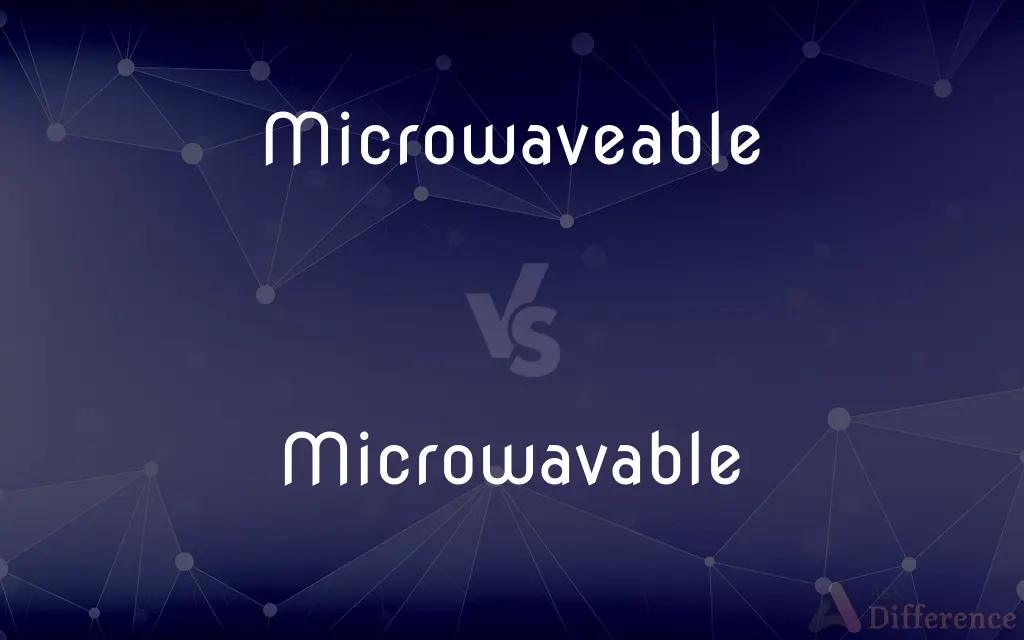Microwaveable vs. Microwavable — What's the Difference?
Edited by Tayyaba Rehman — By Fiza Rafique — Updated on April 22, 2024
Microwaveable and microwavable both describe items suitable for microwave use, but "microwavable" is more common in usage.

Difference Between Microwaveable and Microwavable
Table of Contents
ADVERTISEMENT
Key Differences
Microwaveable items are those that can safely be heated in a microwave oven. Whereas, the term microwavable refers to the same concept, emphasizing the compatibility of materials or food with microwave heating. Both terms are used interchangeably in everyday language to describe containers, packaging, and food products that can withstand microwave temperatures without melting, warping, or releasing harmful chemicals.
Microwaveable materials often include specific types of plastics, ceramics, and glass that do not absorb the microwave radiation but rather allow it to pass through and heat the food. On the other hand, microwavable items are sometimes labeled explicitly to reassure consumers of their safety and suitability for use in microwave ovens, helping to avoid any damage to the microwave or harm to the user.
Microwaveable products are designed to make the preparation of meals more convenient and quicker, by reducing cooking time significantly. While, products labeled as microwavable are often part of product packaging innovations that aim to enhance the functionality of food packaging, making it easier for consumers to heat and serve meals directly in the packaging.
Microwaveable cooking aids, such as steam bags and trays, are engineered to optimize the cooking of various foods in the microwave. Whereas, microwavable containers are often designed with vents or lids specifically made to handle the steam and pressure build-up that occurs during microwave cooking.
Both microwaveable and microwavable serve to convey the suitability of an item for microwave use, though there is no technical difference between the terms. They provide a guarantee that the use of the item in a microwave will be effective and safe, adhering to modern convenience and health standards.
ADVERTISEMENT
Comparison Chart
Definition
Suitable for microwave use
Suitable for microwave use
Common Usage
Less commonly used
More commonly used
Associated Products
Containers, plastics
Containers, food packaging
Consumer Assurance
Safety in microwave use
Explicit labeling for microwave safety
Design Features
May include heat-resistant materials
Often includes specific features like vents
Compare with Definitions
Microwaveable
Referring to a product that can withstand microwave radiation.
Always use microwaveable glassware to prevent accidents.
Microwavable
Designed for convenience in heating or cooking in a microwave.
Many frozen foods are packaged in microwavable containers.
Microwaveable
Capable of being heated quickly and evenly in a microwave.
Microwaveable meals are perfect for a quick dinner.
Microwavable
Safe for use in microwave ovens without causing damage or hazards.
Use only microwavable utensils to ensure food safety.
Microwaveable
Pertaining to items that do not interfere with microwave operations.
Our new range of microwaveable kitchenware is now available.
Microwavable
Suitable for rapid heating while maintaining the quality of the food.
This soup is ideal for a microwavable lunch option.
Microwaveable
Suitable for being used in a microwave to heat or cook food.
Check if the container is microwaveable before heating your meal.
Microwavable
Engineered to withstand the conditions inside a microwave oven.
The new line of dishes is both decorative and microwavable.
Microwaveable
Designed to be safe for microwave use without melting or releasing toxins.
Only use microwaveable plastics to avoid health risks.
Microwavable
Fit for microwave use, usually marked on packaging.
The packaging clearly states that the product is microwavable.
Microwaveable
Relating to or being electromagnetic radiation between radio waves and infrared waves in the electromagnetic spectrum, having frequencies between 300 megahertz and 300 gigahertz and wavelengths between 1 meter and 1 millimeter.
Microwavable
Relating to or being electromagnetic radiation between radio waves and infrared waves in the electromagnetic spectrum, having frequencies between 300 megahertz and 300 gigahertz and wavelengths between 1 meter and 1 millimeter.
Microwaveable
A wave of microwave radiation.
Microwavable
A wave of microwave radiation.
Microwaveable
A microwave oven.
Microwavable
A microwave oven.
Microwaveable
To cook or heat (food) in a microwave oven.
Microwavable
To cook or heat (food) in a microwave oven.
Microwaveable
Alternative spelling of microwavable
Microwavable
Suitable for heating in a microwave oven; said of food and non-food items, especially containers.
Common Curiosities
Is there a standard test that products undergo to be labeled as microwaveable or microwavable?
Yes, products are generally tested for temperature safety and chemical stability under microwave conditions before being labeled as microwaveable or microwavable.
Can coloring or decorations on microwaveable or microwavable containers affect their safety?
Yes, decorations, especially metallic ones, can cause sparks or fires in microwaves, so only use containers specifically marked as microwave-safe.
What happens if a non-microwavable item is microwaved?
Microwaving non-microwavable items can cause them to melt, warp, or even release harmful chemicals, besides potentially damaging the microwave oven.
Can microwaveable or microwavable containers be reused?
Many can be reused if they are designed for multiple uses, but disposable ones should not be reused due to the risk of degrading their microwave-safe properties.
Are microwaveable and microwavable labels recognized internationally?
While the terms are widely recognized, labeling standards can vary by country, so it’s important to check local regulations and standards.
Are there any specific storage guidelines for microwaveable or microwavable containers?
It's best to store them away from extreme temperatures and sunlight to maintain their structural integrity and safety features.
Are there any health risks associated with using non-microwaveable items in a microwave?
Yes, using non-microwaveable items can lead to chemical leaching into food and potentially cause health risks, or physically damage the microwave.
How long can a microwaveable or microwavable container be expected to last?
The lifespan depends on the material and frequency of use, but manufacturers typically provide guidelines on durability and when to replace them.
Do microwaveable and microwavable items need special care during cleaning?
Yes, it's important to follow manufacturer guidelines, which often recommend gentle washing to avoid damaging the microwave-safe coating.
Can microwaving microwaveable or microwavable food containers cause changes in the food's nutritional content?
Microwaving food can sometimes alter its nutritional content, but using microwave-safe containers ensures these changes are no more significant than those occurring with other cooking methods.
How does microwave radiation interact with microwaveable and microwavable materials?
Microwave radiation heats food by agitating water molecules, while microwaveable and microwavable materials are designed to withstand this without heating up excessively themselves.
Are there any materials that are universally considered non-microwaveable?
Yes, metals and some types of plastics are generally considered unsafe for use in microwaves due to sparking and chemical leaching risks.
How do manufacturers ensure a container is microwaveable or microwavable?
They conduct tests such as heat resistance, chemical stability, and durability under microwave conditions to ensure safety and functionality.
Can all foods be cooked in microwaveable or microwavable containers?
While most foods can be microwaved safely, it’s important to use appropriate containers for specific types of food, especially those with high fat or sugar content, which may require special containers to avoid overheating or burning.
Are there environmental benefits to using microwaveable or microwavable containers?
These containers can reduce cooking energy consumption compared to conventional ovens and stoves, potentially lowering environmental impact.
Share Your Discovery

Previous Comparison
Cup vs. Mug
Next Comparison
Contract vs. BondAuthor Spotlight
Written by
Fiza RafiqueFiza Rafique is a skilled content writer at AskDifference.com, where she meticulously refines and enhances written pieces. Drawing from her vast editorial expertise, Fiza ensures clarity, accuracy, and precision in every article. Passionate about language, she continually seeks to elevate the quality of content for readers worldwide.
Edited by
Tayyaba RehmanTayyaba Rehman is a distinguished writer, currently serving as a primary contributor to askdifference.com. As a researcher in semantics and etymology, Tayyaba's passion for the complexity of languages and their distinctions has found a perfect home on the platform. Tayyaba delves into the intricacies of language, distinguishing between commonly confused words and phrases, thereby providing clarity for readers worldwide.














































